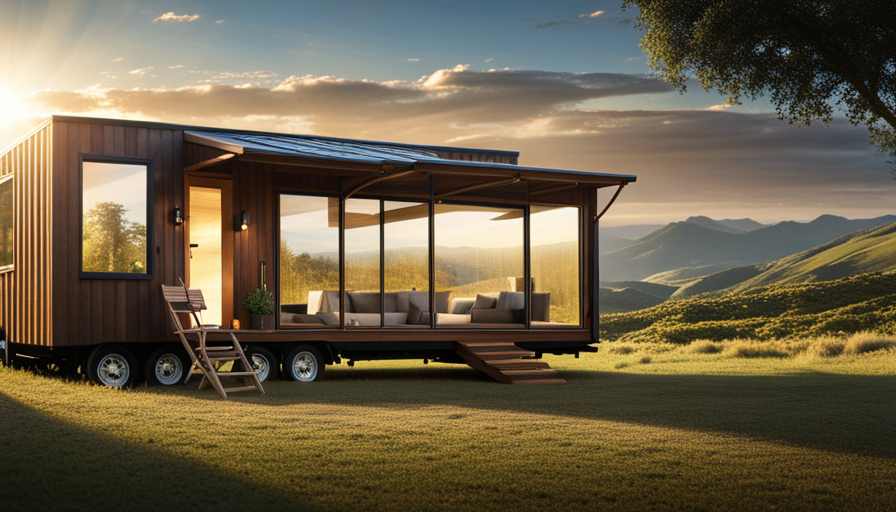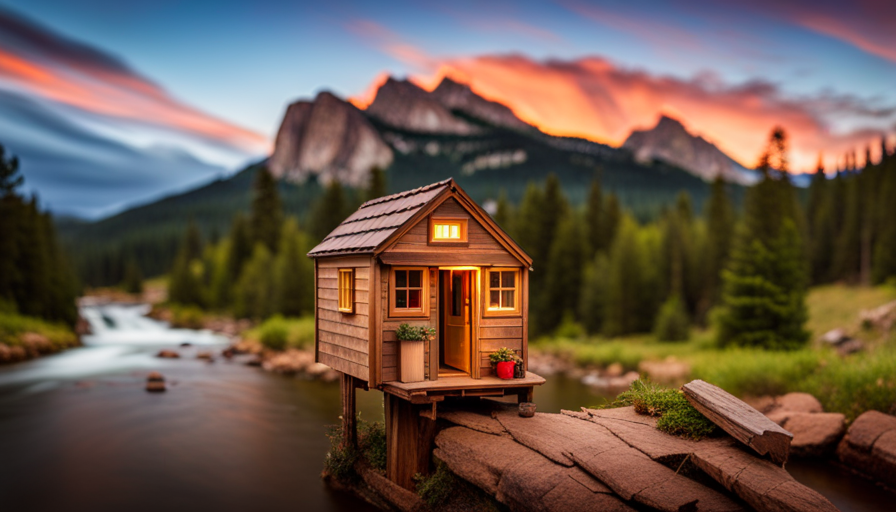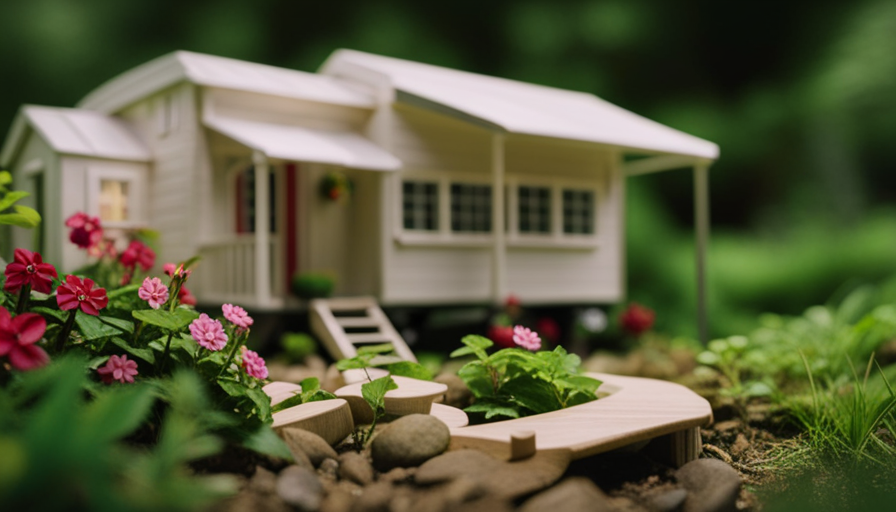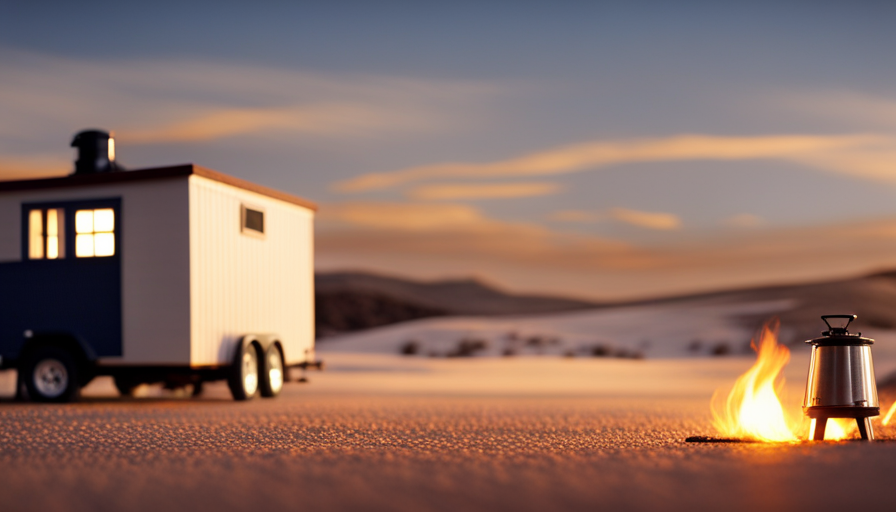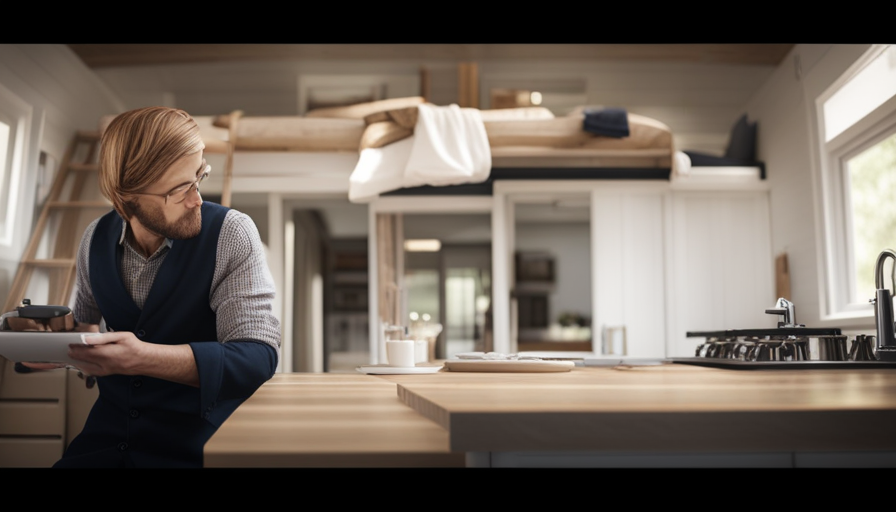Do you ever dream about building a small house on wheels? I certainly do! But before diving into this exciting project, it’s important to consider the costs. Constructing a tiny house on wheels offers a great chance to streamline your living space, save money, and adopt a more eco-friendly lifestyle. However, understanding the financial commitment involved is crucial.
In this article, we will explore the various factors that contribute to the overall cost of building a tiny house on wheels. From determining your budget and choosing the right trailer to calculating the cost of materials and labor, we’ll break down each step in detail. We’ll also discuss financing options, maintenance, and the many benefits of tiny house living.
So, if you’re ready to embark on this incredible journey, let’s dive in and find out just how much it costs to build a tiny house on wheels!
Key Takeaways
- Factors that contribute to the overall cost include budget, trailer choice, materials, and labor.
- Prioritize expenses and budget planning are crucial steps.
- Research and choose a durable trailer that can withstand the weight of the house.
- Calculate the cost of materials by creating a detailed list and researching prices from various suppliers.
Determine Your Budget and Prioritize Expenses
Now, let’s figure out how much money you can allocate for your tiny house on wheels and what expenses should take precedence. Prioritizing expenses and budget planning are crucial steps in the process of building a tiny house on wheels.
The first thing you need to do is determine your budget. Consider your current financial situation and how much you’re willing to spend on your tiny house. Take into account not only the cost of materials and labor but also any additional expenses such as permits, insurance, and utilities.
Once you have a budget in mind, it’s important to prioritize your expenses. Start by identifying the essential elements of your tiny house, such as a sturdy foundation, a reliable electrical system, and a functional plumbing system. These are the areas where you should allocate a significant portion of your budget. Remember, it’s better to invest in quality materials and professional assistance to ensure the longevity and safety of your tiny house.
After prioritizing your expenses, you can allocate the remaining budget to other aspects of your tiny house, such as interior finishes, appliances, and furnishings. Research and choose the right trailer that suits your needs and budget. This will be the foundation of your tiny house on wheels, so make sure to invest in a trailer that’s durable and can withstand the weight of your house.
Research and Choose the Right Trailer
Selecting the perfect trailer for your pint-sized abode-on-wheels is like finding a needle in a haystack. It requires careful consideration of size and weight considerations, as well as an understanding of different trailer types and features.
When choosing the right trailer, it’s crucial to ensure that it can accommodate the dimensions of your tiny house and withstand the weight of the structure. You’ll need to take into account the length, width, and height of the trailer to ensure a proper fit. Additionally, considering the weight capacity is essential to ensure safe towing.
Researching trailer options is another crucial step in the process. It’s important to compare costs and find the best value for your budget. Remember to also consider the durability and lifespan of the trailer, as this will affect its long-term functionality. Additionally, be sure to research towing and parking regulations in your area to ensure compliance with local laws.
Choosing the right trailer is just the beginning of your tiny house journey. Once you’ve found the perfect one, you can move on to designing your tiny house layout, where you’ll get to unleash your creativity and make your dream home on wheels a reality.
Design Your Tiny House Layout
Crafting the perfect layout for your compact dwelling allows you to unleash your imagination and transform your pint-sized abode into a cozy and functional sanctuary. When designing your tiny house layout, it’s important to consider both aesthetic appeal and practicality. One of the key aspects to focus on is maximizing storage space, as every inch counts in a tiny home.
To make the most of your limited square footage, consider incorporating clever storage solutions such as built-in cabinets, multi-purpose furniture, and hidden compartments. Utilizing vertical space is also crucial, so think about installing shelves or hooks on walls to keep your belongings organized and easily accessible.
In addition to storage, tiny house decorating ideas can also play a significant role in creating a visually appealing and inviting space. Choose a color scheme that reflects your personal style and makes the space feel larger. Opt for light-colored walls and furniture to create an open and airy atmosphere. Strategically placed mirrors can also give the illusion of a bigger space.
By carefully planning your tiny house layout and incorporating these decorating ideas, you can create a functional and beautiful living space. In the next section, we will discuss how to calculate the cost of materials for your tiny house build.
Calculate the Cost of Materials
To accurately estimate the expenses for your compact dwelling, you’ll need to calculate the cost of materials required for constructing your tiny house. This cost breakdown will help you understand how much each component will contribute to the overall budget.
When calculating the cost of materials, it’s important to consider factors such as the size of your tiny house, the type of materials you plan to use, and any additional features or customization you desire.
Start by creating a detailed list of all the materials needed for your tiny house, including lumber, insulation, roofing materials, siding, windows, doors, and fixtures. Research the prices of these materials from various suppliers to ensure you get the best possible deals. Consider alternative options and cost-saving tips, such as using reclaimed materials or purchasing in bulk.
Additionally, don’t forget to account for any tools or equipment you may need to purchase or rent for the construction process. These costs can add up quickly, so it’s essential to include them in your budget.
By carefully calculating the cost of materials, you can get a better understanding of the financial aspect of building a tiny house.
In the next section, we will estimate the cost of labor involved in constructing your compact abode.
Estimate the Cost of Labor
When estimating the cost of labor for building a tiny house on wheels, there are several key points to consider.
First, I need to decide whether I’ll hire professionals or take on the project myself. This decision will greatly impact the overall cost.
Secondly, I’ll need to research the cost of skilled labor in my area to get a better understanding of the potential expenses.
Lastly, I must carefully consider the time and effort required for construction, as this will also factor into the overall cost of labor.
By considering these key points, I can make a more informed decision and accurately estimate the cost of labor for building my tiny house.
Decide if you will hire professionals or DIY
Imagine the thrill and satisfaction you’ll feel as you take charge of building your own tiny house on wheels, saving a significant amount of money in the process!
When it comes to deciding if you will hire professionals or take the DIY route, there are a few factors to consider. Hiring professionals can provide peace of mind knowing that experienced individuals will handle the construction. However, this option can be costly as skilled labor comes at a price.
On the other hand, opting for a DIY approach can be a more budget-friendly choice. It allows you to have full control over the project and learn valuable skills along the way. Researching the cost of skilled labor in your area will give you an idea of the potential savings you can achieve by taking on the project yourself.
Research the cost of skilled labor in your area
Discovering the going rate for skilled labor in your local area could reveal surprising opportunities for cost savings on your tiny house construction project. Researching local contractors is a crucial step in understanding the cost of skilled labor.
Start by gathering quotes from different contractors who specialize in tiny house construction. Compare the prices of different types of skilled labor, such as carpentry, electrical, plumbing, and roofing. Take into account the level of expertise and experience each contractor offers. Some contractors may offer lower prices, but their work may not be of the same quality as more expensive options. Consider the reputation and reviews of each contractor as well.
This research will help you make an informed decision and potentially save money on your tiny house build. When considering the time and effort required for construction, it’s important to factor in the costs of skilled labor as well.
Consider the time and effort required for construction
Taking into account the level of expertise and experience required, it is essential to consider the time and effort involved in constructing a tiny house. Time management plays a crucial role in ensuring the project is completed efficiently. By carefully planning the construction timeline and utilizing efficient construction techniques, the process can be streamlined and unnecessary delays can be avoided. It is important to allocate sufficient time for each step of the construction process, including framing, insulation, plumbing, electrical work, and interior finishing. Additionally, the effort required for construction should not be underestimated. Building a tiny house on wheels requires physical labor and attention to detail throughout the entire process. By carefully considering the time and effort involved, you can better plan for additional expenses in the subsequent section about ‘plan for additional expenses’.
Plan for Additional Expenses
Once you start down the path of building a tiny house on wheels, be prepared for the flood of unexpected expenses that will come crashing down like a relentless storm. It’s crucial to plan for additional expenses to avoid financial strain.
One aspect to consider is the need for additional resources. While the basic construction materials are accounted for, there are numerous other items required to complete the project. These can include plumbing fixtures, electrical wiring, insulation, and appliances. It’s important to research and budget for these extra expenses to prevent surprises along the way.
Smart building techniques can also add to the overall cost of building a tiny house on wheels. These techniques focus on utilizing sustainable and energy-efficient materials, which may come with a higher price tag. However, they can result in long-term savings on energy bills and reduce your ecological footprint. It’s essential to weigh the upfront cost against the long-term benefits and decide which options align with your goals and budget.
As you plan for additional expenses, it’s crucial to research financing options. Understanding the available loans, grants, and payment plans can help you secure the necessary funds and make informed decisions. By exploring different financing avenues, you can ensure that your dream of owning a tiny house on wheels becomes a reality.
Research Financing Options
When it comes to funding your dream of a mobile home, exploring various financing options is essential. There are numerous financing options available to help you build your tiny house on wheels. Here are five financing options and loan programs to consider:
-
Personal Loans: Personal loans can be used for a variety of purposes, including financing a tiny house on wheels. They typically have fixed interest rates and repayment terms.
-
RV Loans: If your tiny house on wheels meets certain criteria, you may be able to secure an RV loan. These loans are specifically designed for recreational vehicles and can provide competitive interest rates.
-
Construction Loans: Construction loans are a popular option for building a tiny house on wheels. These loans provide funding for the construction process and are typically converted into a mortgage once the project is complete.
-
Home Equity Loans: If you already own a property with equity, you may be able to use a home equity loan to finance your tiny house on wheels. This type of loan uses your home’s equity as collateral.
-
Peer-to-Peer Lending: Peer-to-peer lending platforms connect borrowers with individual investors. These platforms can offer competitive interest rates and flexible repayment terms.
It’s important to research and compare different financing options to find the one that best suits your needs and financial situation. Once you’ve secured financing, you can set realistic expectations and adjust as needed to ensure your tiny house on wheels becomes a reality.
Set Realistic Expectations and Adjust as Needed
Don’t get carried away with your dreams of a mobile home on wheels – it’s time to set realistic expectations and make necessary adjustments along the way!
When it comes to building a tiny house on wheels, it’s important to understand that managing costs and adjusting expectations will be key factors in ensuring a successful project.
Building a tiny house on wheels can be a cost-effective alternative to traditional housing, but it’s crucial to have a clear understanding of your budget limitations. As you start the building process, you may need to make adjustments to your initial plans to stay within your budget. This could involve compromising on certain features or materials, or finding creative solutions to reduce costs without sacrificing quality.
It’s also important to remember that unexpected expenses may arise during the building process. Whether it’s a change in building codes or unforeseen structural issues, it’s crucial to have a contingency plan in place to accommodate these unexpected costs. By setting realistic expectations and being prepared for potential challenges, you can avoid unnecessary stress and stay on track with your budget.
As you move forward with your tiny house on wheels project, don’t forget about maintenance and upkeep. These ongoing expenses should be factored into your budget and plans to ensure the long-term sustainability of your mobile home.
Transitioning into the next section, it’s important to consider the maintenance and upkeep of your tiny house on wheels to ensure its longevity.
Don’t Forget about Maintenance and Upkeep
When considering the costs of building a tiny house on wheels, it’s important not to overlook the expenses associated with maintenance and upkeep. Budgeting for regular maintenance and repairs is crucial to ensure that the house remains in good condition and functions properly.
Additionally, it’s essential to consider the cost of insurance and property taxes, as these can add up over time.
Lastly, planning for ongoing utility expenses and waste management is necessary to ensure that the house remains functional and environmentally responsible.
Budget for regular maintenance and repairs
Maintaining and repairing a tiny house on wheels can be an exciting journey that adds character and charm to your cozy living space. However, it’s important to budget for regular maintenance and the cost of repairs to ensure your tiny house remains in top-notch condition.
When creating your budget, consider factors such as the age of your tiny house, the materials used in its construction, and any specific features that may require additional upkeep. Regular maintenance tasks, such as inspecting the roof, checking the plumbing, and servicing the heating and cooling systems, should be included in your budget.
Additionally, it’s wise to set aside a portion of your budget for unexpected repairs that may arise over time. By properly budgeting for maintenance and repairs, you can ensure that your tiny house on wheels remains a comfortable and safe haven.
As you consider the cost of insurance and property taxes, it’s important to factor these expenses into your overall budget as well.
Consider the cost of insurance and property taxes
To protect your beloved tiny home and ensure its longevity, it’s worth considering the peace of mind that comes with insuring your cozy abode and taking care of property taxes.
Insurance costs for a tiny house on wheels can vary depending on factors such as the value of your home, its location, and your insurance provider. On average, you can expect to pay between $500 and $1,500 per year for insurance coverage. It’s important to carefully review your policy to understand what’s covered and any limitations or exclusions.
Additionally, property tax implications should be considered. Depending on local regulations, you may be required to pay property taxes, which can range from a few hundred dollars to over a thousand dollars annually. These costs should be factored into your overall budget for maintaining your tiny home.
As you plan for ongoing utility expenses and waste management, it’s important to consider how these costs will fit into your overall financial plan.
Plan for ongoing utility expenses and waste management
Don’t forget to factor in ongoing utility expenses and waste management into your budget as you plan for the long-term sustainability of your tiny home. While the initial cost of building a tiny house on wheels may be lower than a traditional home, it’s important to consider the ongoing costs associated with utilities.
Depending on your location and personal preferences, you may need to budget for electricity, water, and propane expenses. Additionally, waste management is another aspect to consider. You’ll need to find suitable solutions for sewage disposal, such as composting toilets or connections to a local septic system.
Researching waste management options and calculating the associated costs will ensure that you are prepared for the ongoing maintenance of your tiny home. With these considerations in mind, you can embrace the benefits of tiny house living, such as reduced environmental impact and financial freedom.
Embrace the Benefits of Tiny House Living
Living in a tiny house is like experiencing pure bliss and ultimate freedom! One of the main benefits of downsizing to a tiny house on wheels is the ability to maximize small spaces. Every inch of the house is carefully designed and utilized to its fullest potential, allowing for a minimalist and clutter-free lifestyle. The compact size of a tiny house encourages us to prioritize what truly matters, helping us to simplify our lives and focus on the things that bring us joy.
One of the advantages of embracing tiny house living is the significant cost savings. With a smaller footprint, utility expenses are greatly reduced. Heating and cooling a tiny house requires much less energy compared to a traditional home, resulting in lower monthly bills. Additionally, the smaller size means less space to clean and maintain, saving both time and money.
Living in a tiny house also allows for a closer connection with nature. Many tiny houses are designed with large windows and outdoor living spaces, bringing the beauty of the outdoors in. Whether it’s enjoying a cup of coffee on the porch or taking a hike in the nearby wilderness, tiny house living encourages us to spend more time outside, appreciating the natural world around us.
Lastly, living in a tiny house promotes a sense of freedom and mobility. With wheels attached, a tiny house can be easily transported to different locations, allowing for a change of scenery whenever desired. This flexibility opens up a world of possibilities, from living closer to loved ones to exploring new places and experiencing different communities.
The benefits of downsizing to a tiny house on wheels are numerous. From the financial advantages to the increased connection with nature and the freedom to move, embracing tiny house living brings about a sense of simplicity, joy, and ultimate freedom.
Frequently Asked Questions
What are some common maintenance and upkeep tasks involved in owning a tiny house on wheels?
Common maintenance tasks for owning a tiny house on wheels include regular cleaning, checking for leaks, maintaining the plumbing and electrical systems, inspecting the trailer and tires, and ensuring proper ventilation. Upkeep responsibilities are essential for the longevity and functionality of the house.
Are there any financing options specifically tailored for building a tiny house on wheels?
Financing options for building a tiny house on wheels can be limited. However, I discovered a loan option tailored specifically for this purpose. With a low interest rate and flexible terms, it made my dream of owning a tiny house a reality.
How can I set realistic expectations for the cost and timeline of building a tiny house on wheels?
Setting cost expectations and estimating the construction timeline for building a tiny house on wheels requires careful planning and research. Factors such as materials, labor, permits, and customization will influence the overall cost and construction time.
What are some benefits of living in a tiny house on wheels compared to a traditional home?
Living in a tiny house on wheels offers benefits of mobility and downsizing advantages. It allows me to have the freedom to travel and explore different places while enjoying a simpler and more minimalistic lifestyle.
What are some additional expenses to consider when building a tiny house on wheels that may not be mentioned in the article?
Additional expenses to consider when building a tiny house on wheels, not mentioned in the article, include potential insurance costs and additional zoning restrictions that may require permits and inspections.
Conclusion
Well, after diving deep into the world of tiny house construction, it’s clear that building one on wheels is no small feat. From determining your budget and researching trailers to calculating material costs and labor, the process can be overwhelming.
But fear not, my fellow adventurers in minimal living! Embrace the joys and challenges of tiny house living, and remember that the cost extends beyond just money. It’s a journey of self-discovery, a lesson in prioritization, and a chance to simplify our lives.
So, set realistic expectations, adjust as needed, and let the tiny house revolution begin!
Hi, I’m Emma. I’m the Editor in Chief of Tiny House 43, a blog all about tiny houses. While tree houses are often associated with childhood, they can be the perfect adult retreat. They offer a cozy space to relax and unwind, surrounded by nature. And since they’re typically built on stilts or raised platforms, they offer stunning views that traditional homes simply can’t match. If you’re looking for a unique and romantic getaway, a tree house tiny house might just be the perfect option.
